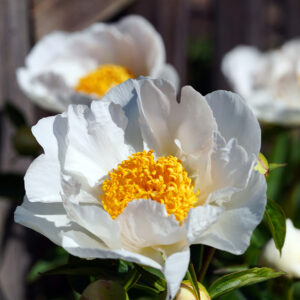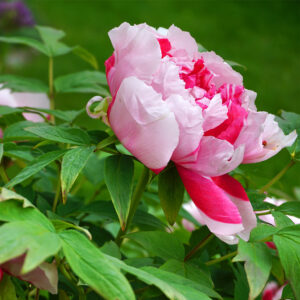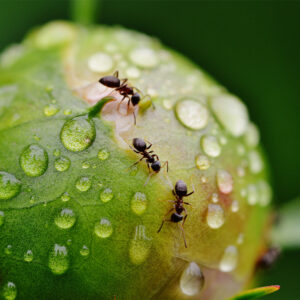It’s that time of year when spring gracefully gives way to summer. The air is warm, the beds and borders are fresh with new growth, and there is anticipation for the bounty of blooms to come. Azalea’s performance is complete; now it’s peony’s time to shine!
Peony Players
There are several main types of peonies:
- Herbaceous
- Tree
- Intersectional
Herbaceous peonies, also called “garden” peonies, are the most popular. These peonies can bloom in white and shades of pink, magenta, raspberry, purple, and red. They frequently have a sweet and pleasing fragrance. Staking should be provided as these plants bloom profusely, with large, heavy flower heads that often bend over from the weight of their blossoms. They are treated as hardy perennials; their green stalks should be cut back to the ground in the fall. These peonies, if well cared for, can live over 100 years. A garden peony’s average size is three feet by three feet.
Tree peonies possess woody stems, which puts them in the shrub category. They bloom earlier than herbaceous peonies. Flower colors are in the same range as garden peonies, with the addition of yellow and bicolor. The opulent flower heads are large, often six to ten inches wide, and the petals have a silky or opalescent appearance. Tree peonies’ overall size is also larger than garden peonies growing to the average size of four to seven feet high and wide, depending on the variety. Size should be considered when planting these beauties in the shrub border.
Intersectional or Itoh peonies are a cross between herbaceous and tree peonies! While the leaves, bloom size, and bloom colors are similar to a tree peony, the bloom time, growth habit, and green stems are comparable to a garden peony. This plant is small, averaging two and a half feet high and about three to four feet wide.
Peony Preferences
Herbaceous:
- Hardiness Zones 3 – 8
- Full sun
- Plant in rich, moist, well-draining soil with a neutral pH
- Root buds should be planted at most only one inch below the soil surface.
- Do not mulch.
- Fertilize as soon as blooming is finished and again in the fall.
- Requires staking
- Blooms for about one week
Tip: Garden peonies are excellent cut flowers; however, wait until year three to cut blooms to enjoy inside. This will allow the plant to strengthen its root system to produce more and bigger blooms once established.
Tree:
- Hardiness Zones 4 – 9
- Dappled sun
- Plant in rich, moist, well-draining soil with a neutral pH
- Planting depth depends on whether the shrub is growing on its own or grafted rootstock.
- Mulch to suppress weeds and to keep the soil moist and cool.
- Fertilize in early spring when growth begins, again in early summer after blooming is through, and finally in the fall.
- Staking not necessary
- Blooms for about three weeks
Tip: Tree peonies are a great plant for the edge of a woodland area where they will receive dappled sun. Try underplanting them with minor bulbs like squill or snowdrops for a spectacular spring display.
Intersectional:
- Hardiness Zones 3 – 9
- Full sun
- Plant in rich, moist, well-draining soil with a neutral pH
- Root buds should be planted at most only one inch below the soil surface.
- Do not mulch.
- Fertilize when the shoots emerge in the spring and again after the blooms fade.
- No staking necessary
- Blooms for an entire month
Tip: Do not cut plants back the first fall. During the second and subsequent falls, after a hard frost, cut back intersectional peony’s green stems to the lower woody portions closer to the ground.
Regardless of which type of peony you choose to grow, you just can’t beat the beauty and longevity of this spectacular garden and landscape plant. Not sure which you should choose? How about all three?
Ants and Peonies
Peony buds are generally covered with ants and lots of them! It is a myth that ants help open the flower buds of peonies. There is, however, a mutually beneficial relationship that takes place between ant and plant. Ants are attracted to the syrupy nectar produced by the peony, and in order to protect their food source, ants will drive off other problem insects, protecting the peony flowers from their damage. Isn’t that sweet?


